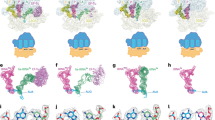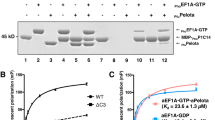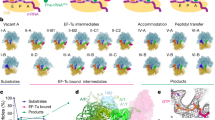Abstract
Following ribosomal peptide bond formation, the reaction products, peptidyl-tRNA and deacylated tRNA, need to be translocated from the A- and P-sites to the P- and E-sites, respectively. This process is facilitated by the GTPase elongation factor G (EF-G). The mechanism describing how the ribosome activates GTP hydrolysis is poorly understood in molecular terms. By using an 'atomic mutagenesis' approach, which allows the manipulation of specific functional groups on 23S rRNA nucleotides in the context of the entire ribosome, we disclose the adenine exocyclic N6 amino group at A2660 of the sarcin-ricin loop as a key determinant for triggering GTP hydrolysis on EF-G. We show that the purine π system–expanding characteristics of the exocyclic functional group at the C6 position of A2660 are essential. We propose that stacking interactions of A2660 with EF-G may act as a molecular trigger to induce repositioning of suspected functional amino acids in EF-G that in turn promote GTP hydrolysis.
This is a preview of subscription content, access via your institution
Access options
Subscribe to this journal
Receive 12 print issues and online access
$259.00 per year
only $21.58 per issue
Buy this article
- Purchase on Springer Link
- Instant access to full article PDF
Prices may be subject to local taxes which are calculated during checkout




Similar content being viewed by others
References
Erlacher, M.D. & Polacek, N. Ribosomal catalysis: the evolution of mechanistic concepts for peptide bond formation and peptidyl-tRNA hydrolysis. RNA Biol. 5, 5–12 (2008).
Chirkova, A., Erlacher, M., Micura, R. & Polacek, N. Chemically engineered ribosomes: a new frontier in synthetic biology. Curr. Org. Chem. 14, 148–161 (2010).
Hauryliuk, V. et al. The pretranslocation ribosome is targeted by GTP-bound EF-G in partially activated form. Proc. Natl. Acad. Sci. USA 105, 15678–15683 (2008).
Rodnina, M.V., Savelsbergh, A., Katunin, V.I. & Wintermeyer, W. Hydrolysis of GTP by elongation factor G drives tRNA movement on the ribosome. Nature 385, 37–41 (1997).
Zavialov, A.V., Hauryliuk, V.V. & Ehrenberg, M. Guanine-nucleotide exchange on ribosome-bound elongation factor G initiates the translocation of tRNAs. J. Biol. 4, 9 (2005).
Blanchard, S.C., Gonzalez, R.L., Kim, H.D., Chu, S. & Puglisi, J.D. tRNA selection and kinetic proofreading in translation. Nat. Struct. Mol. Biol. 11, 1008–1014 (2004).
Datta, P.P., Sharma, M.R., Qi, L., Frank, J. & Agrawal, R.K. Interaction of the G′ domain of elongation factor G and the C-terminal domain of ribosomal protein L7/L12 during translocation as revealed by cryo-EM. Mol. Cell 20, 723–731 (2005).
Moazed, D., Robertson, J.M. & Noller, H.F. Interaction of elongation factors EF-G and EF-Tu with a conserved loop in 23S RNA. Nature 334, 362–364 (1988).
Stark, H., Rodnina, M.V., Wieden, H.J., van Heel, M. & Wintermeyer, W. Large-scale movement of elongation factor G and extensive conformational change of the ribosome during translocation. Cell 100, 301–309 (2000).
Diaconu, M. et al. Structural basis for the function of the ribosomal L7/12 stalk in factor binding and GTPase activation. Cell 121, 991–1004 (2005).
Rodnina, M.V. et al. Thiostrepton inhibits the turnover but not the GTPase of elongation factor G on the ribosome. Proc. Natl. Acad. Sci. USA 96, 9586–9590 (1999).
Connell, S.R. et al. Structural basis for interaction of the ribosome with the switch regions of GTP-bound elongation factors. Mol. Cell 25, 751–764 (2007).
Valle, M. et al. Incorporation of aminoacyl-tRNA into the ribosome as seen by cryo-electron microscopy. Nat. Struct. Biol. 10, 899–906 (2003).
Villa, E. et al. Ribosome-induced changes in elongation factor Tu conformation control GTP hydrolysis. Proc. Natl. Acad. Sci. USA 106, 1063–1068 (2009).
Gao, Y.G. et al. The structure of the ribosome with elongation factor G trapped in the posttranslocational state. Science 326, 694–699 (2009).
Schmeing, T.M. et al. The crystal structure of the ribosome bound to EF-Tu and aminoacyl-tRNA. Science 326, 688–694 (2009).
Endo, Y., Mitsui, K., Motizuki, M. & Tsurugi, K. The mechanism of action of ricin and related toxic lectins on eukaryotic ribosomes. The site and the characteristics of the modification in 28 S ribosomal RNA caused by the toxins. J. Biol. Chem. 262, 5908–5912 (1987).
Endo, Y. & Wool, I.G. The site of action of alpha-sarcin on eukaryotic ribosomes. The sequence at the alpha-sarcin cleavage site in 28 S ribosomal ribonucleic acid. J. Biol. Chem. 257, 9054–9060 (1982).
Hausner, T.P., Atmadja, J. & Nierhaus, K.H. Evidence that the G2661 region of 23S rRNA is located at the ribosomal binding sites of both elongation factors. Biochimie 69, 911–923 (1987).
Benson, S., Olsnes, S., Pihl, A., Skorve, J. & Abraham, A.K. On the mechanism of protein-synthesis inhibition by abrin and ricin. Inhibition of the GTP-hydrolysis site on the 60-S ribosomal subunit. Eur. J. Biochem. 59, 573–580 (1975).
Sperti, S., Montanaro, L., Mattioli, A. & Testoni, G. Relationship between elongation factor I- and elongation factor II- dependent guanosine triphosphatase activities of ribosomes. Inhibition of both activities by ricin. Biochem. J. 148, 447–451 (1975).
Obrig, T.G., Moran, T.P. & Brown, J.E. The mode of action of Shiga toxin on peptide elongation of eukaryotic protein synthesis. Biochem. J. 244, 287–294 (1987).
Montanaro, L., Sperti, S. & Stirpe, F. Inhibition by ricin of protein synthesis in vitro. Ribosomes as the target of the toxin. Biochem. J. 136, 677–683 (1973).
Nilsson, L. & Nygard, O. The mechanism of the protein-synthesis elongation cycle in eukaryotes. Effect of ricin on the ribosomal interaction with elongation factors. Eur. J. Biochem. 161, 111–117 (1986).
Erlacher, M.D. et al. Chemical engineering of the peptidyl transferase center reveals an important role of the 2′-hydroxyl group of A2451. Nucleic Acids Res. 33, 1618–1627 (2005).
Erlacher, M.D. et al. Efficient ribosomal peptidyl transfer critically relies on the presence of the ribose 2′-OH at A2451 of 23S rRNA. J. Am. Chem. Soc. 128, 4453–4459 (2006).
Lang, K., Erlacher, M., Wilson, D.N., Micura, R. & Polacek, N. The role of 23S ribosomal RNA residue A2451 in peptide bond synthesis revealed by atomic mutagenesis. Chem. Biol. 15, 485–492 (2008).
Amort, M. et al. An intact ribose moiety at A2602 of 23S rRNA is key to trigger peptidyl-tRNA hydrolysis during translation termination. Nucleic Acids Res. 35, 5130–5140 (2007).
Chan, Y.L., Dresios, J. & Wool, I.G. A pathway for the transmission of allosteric signals in the ribosome through a network of RNA tertiary interactions. J. Mol. Biol. 355, 1014–1025 (2006).
Lancaster, L., Lambert, N.J., Maklan, E.J., Horan, L.H. & Noller, H.F. The sarcin-ricin loop of 23S rRNA is essential for assembly of the functional core of the 50S ribosomal subunit. RNA 14, 1999–2012 (2008).
Mohr, D., Wintermeyer, W. & Rodnina, M.V. GTPase activation of elongation factors Tu and G on the ribosome. Biochemistry 41, 12520–12528 (2002).
Savelsbergh, A., Mohr, D., Kothe, U., Wintermeyer, W. & Rodnina, M.V. Control of phosphate release from elongation factor G by ribosomal protein L7/12. EMBO J. 24, 4316–4323 (2005).
Seo, H.S. et al. EF-G-dependent GTPase on the ribosome. conformational change and fusidic acid inhibition. Biochemistry 45, 2504–2514 (2006).
Munishkin, A. & Wool, I.G. The ribosome-in-pieces: binding of elongation factor EF-G to oligoribonucleotides that mimic the sarcin/ricin and thiostrepton domains of 23S ribosomal RNA. Proc. Natl. Acad. Sci. USA 94, 12280–12284 (1997).
Qin, Y. et al. The highly conserved LepA is a ribosomal elongation factor that back-translocates the ribosome. Cell 127, 721–733 (2006).
Schuette, J.C. et al. GTPase activation of elongation factor EF-Tu by the ribosome during decoding. EMBO J. 28, 755–765 (2009).
Macbeth, M.R. & Wool, I.G. The phenotype of mutations of G2655 in the sarcin/ricin domain of 23 S ribosomal RNA. J. Mol. Biol. 285, 965–975 (1999).
Leonov, A.A., Sergiev, P.V., Bogdanov, A.A., Brimacombe, R. & Dontsova, O.A. Affinity purification of ribosomes with a lethal G2655C mutation in 23 S rRNA that affects the translocation. J. Biol. Chem. 278, 25664–25670 (2003).
Chan, Y.L., Correll, C.C. & Wool, I.G. The location and the significance of a cross-link between the sarcin/ricin domain of ribosomal RNA and the elongation factor-G. J. Mol. Biol. 337, 263–272 (2004).
Marchant, A. & Hartley, M.R. Mutational studies on the alpha-sarcin loop of Escherichia coli 23S ribosomal RNA. Eur. J. Biochem. 226, 141–147 (1994).
Tapprich, W.E. & Dahlberg, A.E. A single base mutation at position 2661 in E. coli 23S ribosomal RNA affects the binding of ternary complex to the ribosome. EMBO J. 9, 2649–2655 (1990).
Daviter, T., Wieden, H.J. & Rodnina, M.V. Essential role of histidine 84 in elongation factor Tu for the chemical step of GTP hydrolysis on the ribosome. J. Mol. Biol. 332, 689–699 (2003).
Sprinzl, M. et al. Regulation of GTPases in the bacterial translation machinery. Biol. Chem. 381, 367–375 (2000).
Long, S.B., Long, M.B., White, R.R. & Sullenger, B.A. Crystal structure of an RNA aptamer bound to thrombin. RNA 14, 2504–2512 (2008).
Khaitovich, P., Tenson, T., Kloss, P. & Mankin, A.S. Reconstitution of functionally active Thermus aquaticus large ribosomal subunits with in vitro-transcribed rRNA. Biochemistry 38, 1780–1788 (1999).
Wilson, K.S. & Nechifor, R. Interactions of translational factor EF-G with the bacterial ribosome before and after mRNA translocation. J. Mol. Biol. 337, 15–30 (2004).
Yu, H., Chan, Y.L. & Wool, I.G. The identification of the determinants of the cyclic, sequential binding of elongation factors tu and g to the ribosome. J. Mol. Biol. 386, 802–813 (2009).
Szaflarski, W. et al. New features of the ribosome and ribosomal inhibitors: non-enzymatic recycling, misreading and back-translocation. J. Mol. Biol. 380, 193–205 (2008).
Acknowledgements
We thank Y.-L. Chan, S. Connell, M. Erlacher, M. Pech, P. Sergiev, T. Tenson, O. Vesper, D. Wilson and M. Zywicki for valuable comments and suggestions. A. Hüttenhofer is acknowledged for his support at the Division of Genomics and RNomics. We thank A. Mankin (University of Illinois at Chicago) and N. Shankaran (University of Illinois at Chicago) for the GAC deletion mutant, M. Sprinzl (University of Bayreuth) for the parental EF-G clone, T. Tenson (University of Tartu) for the LepA clone and W. Piendl and G. Brosch for help with the EF-G and LepA purifications, respectively. We acknowledge F. Handle for experimental help during a lab rotation. This work was funded by the Austrian Science Foundation (FWF) (I317 and P21641 to R.M. and Y315 to N.P.) and the Austrian Ministry of Science and Research (GenAU project consortium 'non-coding RNAs' P0726-012-012 to R.M. and D-110420-012-012 to N.P.).
Author information
Authors and Affiliations
Contributions
N.C. established the GTPase and EF-G binding assays with reconstituted ribosomes and contributed to all figures. A.C. optimized the in vitro translation assay and contributed to Figure 3 and Supplementary Figure 2. B.P. synthesized non-natural nucleoside analogs under the supervision of R.M. N.P., R.M. and N.C. analyzed the data. N.P. designed the study and wrote the paper (together with R.M. and N.C.).
Corresponding author
Ethics declarations
Competing interests
The authors declare no competing financial interests.
Supplementary information
Supplementary Text and Figures
Supplementary Methods and Supplementary Figures 1–8 (PDF 4094 kb)
Rights and permissions
About this article
Cite this article
Clementi, N., Chirkova, A., Puffer, B. et al. Atomic mutagenesis reveals A2660 of 23S ribosomal RNA as key to EF-G GTPase activation. Nat Chem Biol 6, 344–351 (2010). https://doi.org/10.1038/nchembio.341
Received:
Accepted:
Published:
Issue Date:
DOI: https://doi.org/10.1038/nchembio.341
This article is cited by
-
Time-resolved cryo-EM visualizes ribosomal translocation with EF-G and GTP
Nature Communications (2021)
-
KRAS regulation by small non-coding RNAs and SNARE proteins
Nature Communications (2019)
-
Human ribosomal P1-P2 heterodimer represents an optimal docking site for ricin A chain with a prominent role for P1 C-terminus
Scientific Reports (2017)
-
The noncoding RNAs SNORD50A and SNORD50B bind K-Ras and are recurrently deleted in human cancer
Nature Genetics (2016)
-
EF-G and EF4: translocation and back-translocation on the bacterial ribosome
Nature Reviews Microbiology (2014)



